The so-called Torlonia relief was found in 1863 at an unspecified location in Portus during excavations initiated by Alessandro Torlonia. The discovery was reported by Pietro Ercole Visconti. It is now part of the private Torlonia collection, since 2021 partly accessible to the public (inv. nr. 430). The harbour of Portus is depicted. The generally accepted date is the end of the second or early third century. This is deduced from the hair style of the woman at the altar in the left ship: that of Julia Domna, wife of Septimius Severus. The time window may be a bit wider though, c. 160-215 AD (Ojeda 2017, 89-90). The only monographs about the relief are two unpublished theses (Marshall 1960; Lamberty 2012; non vidi). The relief is an essential piece of evidence in the discussions about the Forum Vinarium.
DESCRIPTION
The relief is made of marble (from Greece?) and measures 1.22 x 0.75 m. The relief is complete. There is light damage, especially on the lower right part of the right ship (a hole below the eye has now been filled). No data are available about the sides and backside (on one photo a large hole in the right side can be seen). Recently traces of paint have been found by Anna Maria Carruba, a member of the restoration team: red (e.g. on the flame that burns at the top of the lighthouse), blue (e.g. on the waves), and green and yellow (e.g. on the frame).
A drawing of the relief after restoration, with indication of the traces of paint. Drawing: Fondazione Torlonia.The relief is surrounded by a moulding. Between the moulding and the outer rim are small round holes. Below the entire scene are waves. The waves carry two ships; the waves below the left ship are higher than the others. Amongst the higher waves are three fish, swimming from left to right.
In the top left corner is a female figure, standing on a square pedestal, facing right. She is dressed in a long mantle, reaching the ankles. With her left hand she holds a cornucopiae. Holes are drilled in the upper part of the cornucopiae. With the right hand she holds a wreath. On her head is a lighthouse consisting of three tapering floors, each with an opening in the centre, and with a cylindrical top floor in which a fire is burning. The lighthouse is similar to many depictions of the lighthouse of Portus, so that the figure must be the personification (Genius) of Portus. On the front of the pedestal a building can be seen, consisting of two floors, each with an opening in the centre, on top of which are two T-shaped structures (battlements?). To the right of the figure flies an eagle with outstretched wings. With his claws he holds a wreath. There is an obvious association with the eagle, the bird of Jupiter, who carried the soul of the deceased emperor from the funeral pyre to heaven (apotheosis).
Further to the right, behind the left ship, is the Claudian lighthouse of Portus that was restored by Antoninus Pius. Four floors are depicted, on top of which is a cylinder in which a fire is burning. The ground floor has virtually the same width as the first upper floor. In the front is a large doorway with a curved lintel. In the interior of the door is a net of diagonal lines, possibly representing the masonry (opus reticulatum) of the interior. In the right side is another large doorway with a curved lintel. In the interior of this door four horizontal bars can be seen, perhaps representing a staircase. In the front of the first upper floor of the lighthouse is a window. In the front of the second and third upper floor is a door. In the right side of the third upper floor is a window. On the third upper floor of the lighthouse is a male, naked (bearded?) figure. With his right hand he holds a lance with a pointed top (or a sceptre?). A mantle is hanging over his left arm. It cannot be seen what is in his left hand, if anything. This is most likely a deified Emperor. On the mantle Ojeda recognizes a parazonium, a long triangular dagger. According to Tuck the figure represents Claudius, Ojeda suggests Trajanus or Antoninus Pius. Further to the right is a male figure standing on a square pedestal, facing left. The lower part of the body is covered by a mantle. With his left hand he holds a cornucopiae, with holes drilled in the upper part. With his right hand he holds a wreath over the head of the figure standing on the lighthouse. It is a Genius, but of what?
A cargo ship occupies most of the left half of the relief. There are clear similarities with the right ship, and it has been suggested that the ships are the same, at different moments in time. The main mast is hidden behind the main sail, which throws real shadows. On the sail we can see ropes, metal rings and leather bands. A very thick rope runs diagonally across the sail, connecting the main mast - just above the yard - with the deck. Both to the left and to the right of the rope are Romulus and Remus, suckled by the she-wolf, facing left and right respectively. Perhaps we should imagine the figures as being embroidered on the sail. Below the twins, again to the left and right of the rope, are the letters V and L (CIL XIV, 2033). There are no parallels for the abbreviation. The two letters have been explained as V(oti) L(itterae) by Henzen, V(itam) L(ongam) by Cavedoni, V(otvm) L(ibero) by P.E. Visconti, V(enus) L (proper name) by C.L. Visconti, and V(otvm) L(ibens) (S(olvit). For Voti Litterae and Votvm Libero (= to Liber Pater, Bacchus) reference is made to the desciptium of the navigium Isidis by Apuleius (Metamorphoses 11,16): Huius felicis alvei nitens carbasus litteras aureas [or: voti; the manuscripts vary] intextas progerebat: eae litterae votum instaurabant de novi commeatus prospera navigatione ("The resplendent sail of this happy vessel displayed letters embroidered in gold repeating the prayer (votum) for the new sailing season and successful navigation"). In the same book (11,17) is fausta vota ... nauticis navibusque ("auspicious prayers ... for the seamen and ships"; translation E.J. Kenney). On top of the main mast is a winged Victoria, standing on a globe and facing right. She wears a long mantle. In her right hand is a wreath, her left hand cannot be seen.
Click to enlarge. Photo: Van Haeperen 2019, fig. 294.
Click to enlarge. Drawing by Giovanni Montiroli (Guglielmotti 1864 [1866]).The ship is sailing to the right, as can be deduced from the position of the large rudder. Between the hull and the rudder is a naked man in a small boat. The boat is in a dangerous place. With both hands the man holds a rope passing through two holes in the rudder, wrapped around the central shaft. Lawrence Mott suggests he is helping to dismount the rudder from a braced mount (Mott 1997, 12, 39-40). Planks and other features on the hull testify to its strengthening and interior structure. On the upper left rim of the hull a serious of symbols is drawn by Montiroli: I, II, a mirrored N, II, a fish, the modern symbol of the astrological sign Gemini, an S-shape, a dot between brackets, and \. Some of this can indeed be seen on the photo. No explanation has so far been offered. On the stern are three figures. A naked female figure holds a veil over her head, with one arm raised and one lowered (Venus?). She is flanked by two smaller figures. The right one is winged, flies to the left, and supports a pole-like object with its hand (Hymenaeus holding a torch?). The left one is standing next to the female figure and, according to the drawing, raises its right arm (holding the veil?). On the prow is a naked male figure. There seems to be an object on his head with a hole in the centre. With his left hand he holds a lance or sceptre. His right arm is hanging down next to his body. In his right hand is an object, and below that another object on the ground (Liber Pater with thyrsus, and cup and panther?).
On the tip of the stern is a winged figure facing right, presumably Victoria. She is wearing a long mantle. A wreath is in her left hand. Her right hand cannot be seen. A bit to the right of this Victoria is a sculptured goose or swan, facing left. This is a common feature on the stern of Roman cargo ships. To the right of the swan is the upper part of a figure. The lower part of his body is hidden behind the cabin of the ship. In this figure the steersman has been recognized, holding the tiller of the rudder with his right hand. A pole running diagonally connects the tiller and the upper part of the rudder. His left hand cannot be seen. His head is damaged. To the left of the main sail, in its shadow, and to the right of a rope is a group of three people in long mantles. They stand in front of more ropes, and on top of the cabin of the ship. The cabin has a heart-shaped window and a door with a curved lintel. A woman is flanked by two bearded men. The woman seems to hold an opened box, the lid resting against her chest. The left man stretches out his right hand to the box, his left hand cannot be seen. The right man has a hollow vessel in his left hand and another object in his right hand. Below the box is an altar. It consists of a table resting on legs and with horn-shaped protuberances on the top. A fire is burning on the altar.
From below the main sail many ropes appear that are fastened to the deck. The head of a bearded man is sticking out between the ropes. To the right sits a bearded man, working on some object standing in front of him with a small pickaxe. A female (?) figure is leaning over his shoulder. On the far right a bearded man wearing a long mantle is operating the bowsprit as crane. With both hands he holds two ropes that lead to a pulley attached to the top of the bowsprit. From there two ropes hang down, leading to another pulley. With the crane a (partly damaged) boat-shaped object (with a dolphin?) is lifted or lowered. Because no bowsprit sail can be seen this might be a new sail.
In front of the left part of the right ship is a bearded Neptunus, naked with a mantle hanging over his left shoulder. He is standing on the platform of the lighthouse (which in reality is an island between the two piers of the Claudian harbour). With his left hand he holds a trident. His right hand is lost. The right ship is behind the lighthouse island, so it has entered the basin of Claudius. It is somewhat smaller than the left ship, presumably because it is farther away. As has been said before, there is a great likeness with the left ship. However, the main sail has been furled, and on the prow is a bust instead of a full figure.
The top of the main mast is egg-shaped, supporting a pinnacle that is pointing, as it were, to the elephant quadriga above. Three sailors are working on the upper part of the ship. One is partially hidden by Neptune's trident, one is seen partly between ropes, and one is hanging on the yard, below which his feet can be seen, resting on a rope. Below the yard a naked sailor is climbing a rope ladder. The lower right part of the ship is much damaged. A large apotropaic eye is floating (or suspended?) in the air. Below the eye the lower part can be seen of a man wearing a mantle and operating the bowsprit as a crane. Again a boat-shaped object is lowered or lifted. Behind the bowsprit and the crane is a rectangle. On the prow is the upper part of the body, a bust, of a person with hair that is very similar to the hair of Liber Pater in the upper right corner.
The ship is moored with a rope to a big ring, inserted in the quay. Similar rings of travertine have been found in Trajan's basin. Below the rope is a small boat, this time without a sailor. A gangway rests on the prow and the quay. It is crossed by a man carrying an amphora on his shoulder, holding it with his left hand. There might be an object in his right hand. Above the porter are three women. Two are partly hidden. The upper part of the central woman is naked. The women empty a vessel (which is not an amphora). It has been suggested that they are Nymphs. The Danaids in Hades come to mind.
In the upper right corner is the naked Liber Pater - Bacchus, not standing on a base, but merely on the ground. His head is crowned with vine leaves. With his left hand he holds the thyrsus. With his right hand he holds a cup over the head of an animal, presumably a panther. To the left of Liber Pater is a quadriga with elephants. It stands upon a base with a moulded ledge (an arch?). The skin of the elephants is rendered with diagonal lines. The upper part of the base is curved upwards, so that three of the elephants are standing at a higher level. The elephants pull a chariot with an unbearded man wearing a long mantle. In his hair is a wreath. There seems to be a large object in his right hand and a doll in his left. Meiggs has suggested that the latter object is a sceptre terminating in a human head (bust). This kind of sceptre is also seen on coins of Domitianus' second consulship in 73 AD. Meiggs remarks that the Emperor is unbearded and cannot therefore be later than Trajan. Also, Domitian is the first Emperor known to have set up an arch surmounted by an elephant chariot in Rome. Henzen points to a similar sceptre held by Antoninus Pius on a base in Villa Pamfili.
INTERPRETATION
The relief is generally and with good reason interpreted as a votive gift to Liber Pater. The emphasis is on transport and the dedicant is therefore a skipper of wine (navicularius), rather than a merchant (negotiator) as is often stated. Many inscriptions from the harbours mention a guild of skippers transporting wine: the skippers of the Adriatic Sea (corpus naviculariorum maris Hadriatici). They came from the shores of that sea, but had their headquarters in Ostia. The relief was originally presumably placed in a temple of Liber Pater. This means that the viewers were familiar with the cult of Liber Pater. And of course they were equally familiar with overseas shipping and the various features in the harbour (the quays, machines, statues and so on).
The relief is divided in two parts. The left part is considerably wider than the right part, it takes up about two-thirds of the relief. The left part is symmetrical, due to the two Genii in the upper part, and at first sight relatively simple. The right part is asymmetrical and looks confused. The symmetry of the left part is created by two very large figures in the upper corners, facing each other. In between is a very large ship, much bigger than the same ship in the right scene. It is in front of the equally large lighthouse. The fire of the lighthouse and an eagle flank the tip of the main mast. In the right half two large figures, one in the lower left corner, one in the upper right, contribute to the asymmetry. An enormous eye floating in front of the ship detracts from the realism of the right scene. The balanced and calm nature of the left scene, and also the sheer size of the ship and the lighthouse, invite the viewer to interpret this scene first, postponing the study of the right and apparently more difficult scene.
The ship in the left scene is sailing past the lighthouse and apparently has reached the harbour safely. On the deck three people are performing a sacrifice. The shade of the main sail gives them a central place. Such a sacrifice was a preparation for the actual placing of a votive gift in a temple. On the sail the letters V L are read (these may have been accentuated originally by paint, like other parts of the relief). The letters draw a lot of attention being the only text on the relief. In view of the context they may be read as VOTVM LIBERO ("votive gift to Liber Pater"), but the use of a single-letter abbreviation without parallels is surprising. Above the letters the she-wolf suckling the twins Romulus and Remus is depicted twice, indicating that there is a strong tie between the ship and Rome, surely that the cargo is meant for Rome.
The figure in the top left corner is easily identified, because it has a lighthouse on its head: it is the Genius of Portus. The pendant is another Genius, without anything specifying its nature. Therefore it seems best to go for the most simple solution: it is the Genius of the guild to which the skipper belongs. Taken together the Genii express the importance of the safe harbour for the guild. The lighthouse is the symbol of safety. On top a fire is burning. The lighthouse is always depicted like this, there is no need to think of a scene by night.
On one of the floors of the lighthouse is a statue of a deified Emperor. The viewers in antiquity of course knew who this was, for us it is difficult to establish. It may be Antoninus Pius, who, according to the Historia Augusta, restored the lighthouse. The fire of the lighthouse is balanced by an eagle, symbolizing the apotheosis of an Emperor. Because of the balancing we might think of the Emperor on the lighthouse, who is below the fire. That however is a rather indirect association, the eagle is not balanced with the statue. It is natural to think of a recently deified Emperor, just before the reign of Septimius Severus and Caracalla, when the relief was made. We must then choose between Pertinax and Commodus (Didius Julianus suffered a damnatio memoriae). Pertinax is an unlikely candidate, he ruled for only 86 days. From Portus comes a dedication to Liber Pater Commodianus. However, there is nothing in the relief that unequivocally points to Commodus. The solution I propose is that the eagle, flying isolated in the sky and balanced only with the fire of the lighthouse, is a reference to all deified Emperors who had contributed to the harbours and the lighthouse, from Claudius to Commodus.
Five wreaths refer to victory by the Emperors: one is held by the Genius of Portus, another over the head of the statue of the Emperor by the other Genius; one is in the claws of the eagle, another is held by a winged Victoria on the tip of the main mast of the ship, the fifth by another Victoria on the tip of the stern of the ship. The Emperors had conquered the dangers of the sea through the construction of the harbour basins and the lighthouse.
I have not been able to find a clue to the explanation of the little crenellated building that is seen behind the Victoria on the tip of the stern. Perhaps it refers to the presence of military men in the port, such as the vigiles and frumentarii. On the prow of the ship a man is lifting or lowering an object with a crane, and the same happens on the right ship. For this too I have not found a solution (surely it is not just a technical demonstration, but has a clear meaning).
The artist is telling us much more in the left part of the relief, but this only becomes apparent upon closer inspection, because the depictions are small. The prow of the ship is decorated with an image of Liber Pater, the stern possibly by Venus accompanied by Hymenaeus, deity of marriage. Between the hull of the stern and the starboard rudder is a man in a small boat, holding on to the ship. He is in a most precarious place. I will return to him later. On the front part of the deck we see a seated man, working on an object with an axe. I do not wish to see a ship carpenter here, because that would merely be a meaningless filling of space. We may recognize in him the artist working on this very relief, inspired by depictions of Daedalus. Behind him a figure is leaning over, possibly a Muse or Nymph-Maenad inspiring him. A simpler solution is that it is the viewer, in other words you. Behind her (or him?) a man emerges from between ropes, contributing to a theatrical effect.
A Daedalus-Icarus mosaic from Zeugma-Commagene. Photo: Wikimedia, Dosseman.The left and right part of the relief are not simply juxtaposed. They are linked together by the left-to-right movement of the left ship, and the left-to-right orientation of the right ship. Three fish below the left ship, amongst the waves, are all moving from left to right. A large Neptune, turned slightly towards our right, seems to introduce us to the scene on the right.
A huge eye, a strong symbolic intrusion, leaves no doubt about the central meaning of this scene: evil is averted, by implication leading to something good. Because of the asymmetry of the scene, the viewer is expected to put some effort in understanding it, in solving the puzzle. The isolated eye gives this a sense of urgency. It is aimed at the viewer, who is therefore on the side of potential evil. The viewer is left with a choice: to remain where he is, or to seek protection.
The ship, the same ship as in the left scene, is now safely moored to a quay on the right. The sail is furled. Four crew members are working among the ropes, one climbing a rope ladder, another - hanging over the yard - looking straight at us. The people on the deck of the left ship have disappeared.
Because of their size the depictions of the upper part of the scene immediately draw attention: Liber Pater and a quadriga with elephants drawing a chariot. Liber Pater is represented as a real deity, not as a statue, because he is not standing on a base. The identity of the man in the chariot, an Emperor, must have been known to the ancient viewers. Domitianus is a possibility, it may also be Antoninus Pius. The quadriga is presumably resting on an arch, although this cannot be recognized as such. On top of the main mast is a pointed, egg-shaped object (a bacchic pineapple?). The apex serves as it were like a "hinge" of the upper part of the arch and points to the quadriga. The quadriga thus becomes the endpoint, the final statement of this scene and of the entire relief.
The last information is provided by, again, small figures, in the lower right corner. Again we see the little boat, but the sailor is no longer on board. Presumably he is the man carrying an amphora from the ship to a warehouse on the quay. Above him, three women are emptying a vessel. They are usually identified as Nymphs, which I do not understand. Rather, we see the Danaids being punished in Hades, where they endlessly carry water to a bottomless vessel. Here the latter vessel is missing. Instead the water seems to flow into the harbour.
Perhaps we should understand the man in opposition to the Danaids. He had done important and dangerous work when the ship entered the harbour. Now he is doing important work again: taking a vessel full of wine to a warehouse. The Danaids merely empty a vessel. The little figure thus becomes the "hero" of the relief. The Danaids (together with Ocnus) also occur in a series of stucco reliefs in a tomb of Portus' Isola Sacra necropolis, from the reign of Hadrian. It contrasts scenes from the underworld with the happy future for those initiated in the mystery cult of Liber Pater, who is mentioned explicitly. In the words of Edu Van Berkel, "the underlying message is clear: one must devote oneself in life to the mysteries in order to gain happiness, yes, even immortality in the hereafter" (Van Berkel 1986; cf. Becatti 1951). Similarly, the Torlonia relief combines safety from the dangers at sea with happiness in the hereafter. So does a mosaic in front of another tomb of the necropolis of Portus. On it, two ships flank the lighthouse, with the Greek text: "Here is the end of all sorrow".
Drawing of a stucco relief of the Danaids and Ocnus in the Underworld.
Isola Sacra necropolis, tomb N.The references to the mystic nature of the cult are tucked away in the corners of the relief and represented by small figures. That is consistent with the hidden aspects of mystery religions. Here we may also have the explanation of the enigmatic single-letter abbreviation, V L, on the main sail of the left ship: a veiled reference to a veiled cult, to be understood only after initiation.
PHOTOS
A photo of the relief after restoration, with traces of paint. Photo: Fondazione Torlonia.
Click on a section to enlarge. Photos: Fondazione Torlonia.
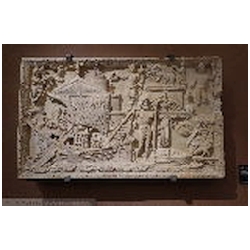
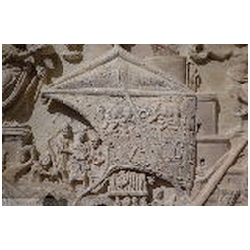
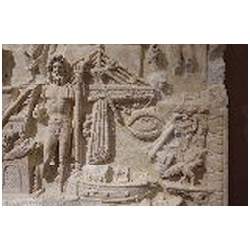
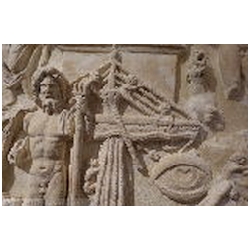
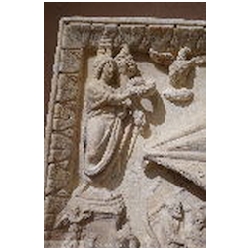
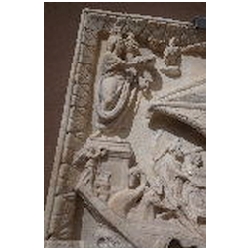
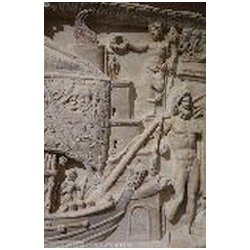
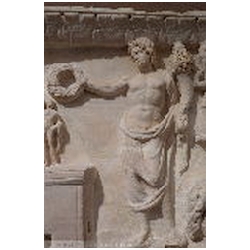
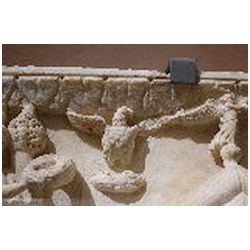
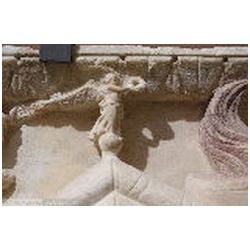
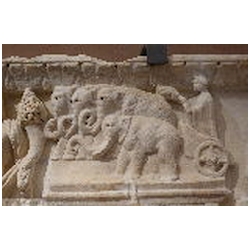
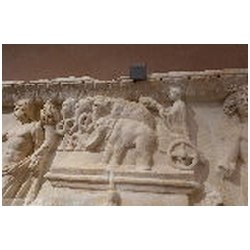
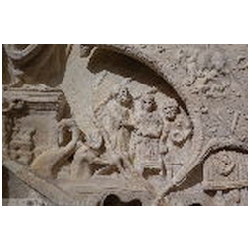
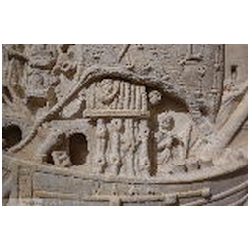

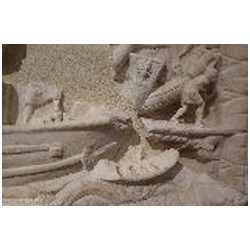
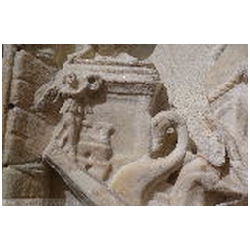
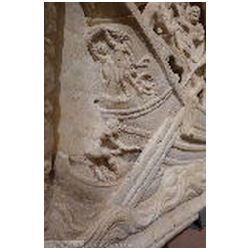
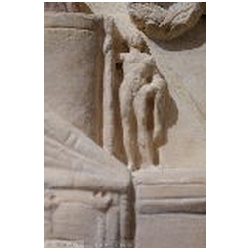
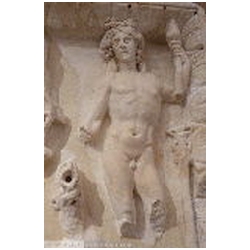
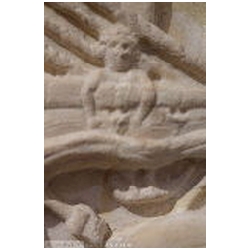
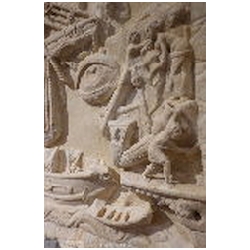
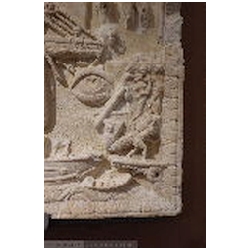
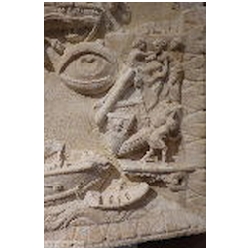
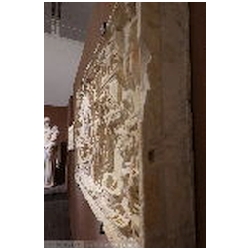
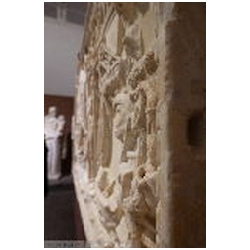
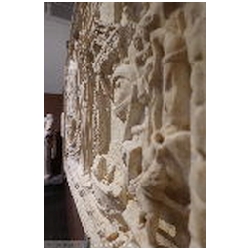
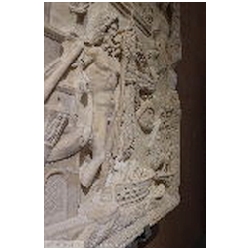
Click on an image to enlarge. Details of the relief after restoration. Photos: Annewies van den Hoek (2022).